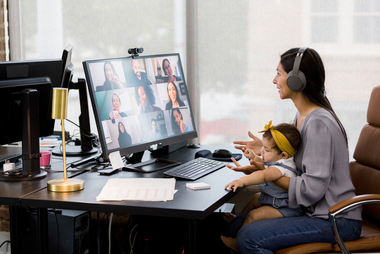A sad truth is emerging: The most common trend in work-from-home may be a regression in gender equality. Studies show women appear to be doing the same or more tasks on the domestic front. When
the pandemic first struck, hopes ran high that radical changes in flexible work-from-home patterns would catalyze gender equality, creating a more level playing field between spouses. With men
doing more around the house during the lockdown, would more equitable gender norms evolve?
An imbalance has persisted for decades. Workplace culture is likely a main driver, which still promotes a norm that for men, work comes before caregiving. Nevertheless, since 1965, men have greatly increased their time spent on child care and housework, from 6.5 hours a week to 18 hours a week, according to Pew Research.
Who does the laundry?
In May 2020, Boston Consulting Group surveyed 3,055 working parents in five countries. Results showed that women spent 15 more hours per week on domestic chores than did their male partners. Now, further studies are showing that the gender gap has barely budged, and possibly even widened, despite upheavals in workplace habits.
Researchers examined the results from an online poll conducted by The New York Times in April 2020. They focused on 478 partnered parents with dependent children and asked them questions about the following as they related to the pandemic:
- Time spent on housework and child care.
- Primary responsibilities for housework and child care.
- Time spent helping children with distance learning.
Bottom line results indicate that both mothers (55%) and fathers (45%) upped their hours devoted to those tasks. But in the end, mothers were shouldering the heavier burden of work, performing 79% of those jobs versus 28% for fathers. Fathers did pitch in — doing far more than during the days when their main or only contribution was taking out the garbage. But even though mothers were now working harder than ever, the ratio for the division of work did not shift.
At the same time, mothers' careers were suffering the most serious damage during the early days of COVID-19. For instance, a large 2020 McKinsey study revealed more mothers quitting the workforce when both parents of dual-earning couples were working remotely.
How does this affect HR?
The work-from-home trend remained even after the pandemic died down. However, working caregivers and parents remain under stress. As before, the onus falls disproportionately on women. Employers have an important part to play, by recognizing their challenges and offering added support options. The pandemic highlighted the difficulties of juggling work and home responsibilities. While flexible work may have eased some pressures, women continue to bear more domestic duties.
Many workers have returned to their offices, while others continue to operate either remotely or on a hybrid schedule. Flexibility has brought many benefits, but more people at home means more mess, more dirt, and more meals to prepare and clean up. Although children are at least back in school for more of the day, floors still need scrubbing and dishwashers unloading.
The bottom line? To keep workers happy and productive, companies need to look at the big picture of how everyone balances their personal and professional lives.
